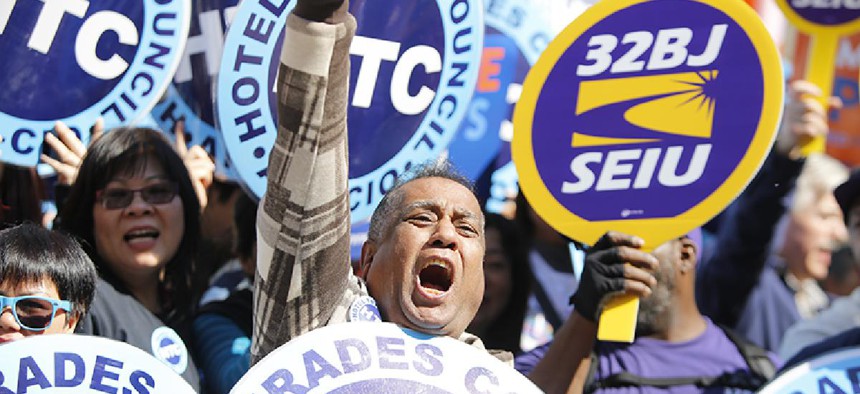In recent months, the labor movement had been on the winning side of the news cycle. First, President Donald Trump’s nominee for labor secretary, fast food executive Andrew Puzder, was withdrawn. Then the push to repeal and replace the Affordable Care Act collapsed.
But on closer examination, both the Puzder flameout and the health care meltdown were mostly due to self-inflicted wounds. The disclosure of Puzder’s domestic violence history and upstate Reps. Chris Collins and John Faso’s attempt to shift county Medicaid costs to their home state exacted a heavy price for Republicans.
In reality, these labor “wins” were rearguard actions by a union movement with fractures between its leadership and its rank and file that Trump, much like former President Ronald Reagan, has already exploited. Trump’s path to the White House was paved when he flipped 200 counties in states like Michigan, Wisconsin, Ohio and Pennsylvania that voted for former President Barack Obama in 2008 and 2012. Trump did that by winning hundreds of thousands of votes from union members whose leaders had bet big on former Secretary of State Hillary Clinton.
RELATED: Trump's budget proposal: How much could New York City lose?
John Samuelsen, president of Transport Workers Union Local 100 and who backed U.S. Sen. Bernie Sanders in last year’s presidential race, said he believes the Democratic Party has lost touch with its blue-collar working-class voters – and Trump has cashed in. Now, Samuelsen said, Trump is courting private sector unions while his budget would lay off thousands of unionized federal workers.
“There is a playbook and it belongs to the illustrious governor of Wisconsin Scott Walker and that playbook was to go after the public sector and sort of tell the uniforms and the trades that everything would be OK and then after he got done gutting the public sector, he gutted everybody else as well,” Samuelsen said. “Walker has had meetings with Trump since the election and hopefully organized labor is not going to be deluded into thinking that can’t happen nationally the way it happened in Wisconsin.”
“(Wisconsin Gov. Scott) Walker has had meetings with Trump since the election and hopefully organized labor is not going to be deluded into thinking that can’t happen nationally the way it happened in Wisconsin.” – John Samuelsen, president of Transport Workers Union Local 100
In 2011, Walker and the Wisconsin state Legislature dismantled decades of labor protections, ending collective bargaining for public unions and requiring them to pay more for their health care and pension benefits. Walker withstood a recall election and went on to win re-election.
Since 2011, union membership has dropped by 40 percent in Wisconsin with just 8 percent of the state’s workers now in a union, well below the national average of 11 percent. During his own short-lived presidential bid, Walker pledged to eliminate the National Labor Relations Board and end union representation for federal workers. “If you’re a big-government union boss in Washington, this is a threat to you and to all of the politicians that you have under your control in our nation’s capital,” Walker said at a Nevada campaign rally, according to Reuters.
Wisconsin passed a right-to-work law, a measure that historically had traction only in the South and West, but in 2012 a similar measure was enacted in Indiana and Michigan. As early as 1995, the American Legislative Exchange Council, a right-wing think tank supported by the Koch brothers, had been pushing state legislatures to adopt the anti-union measure.
By contrast, New York has the highest percentage of unionized workers in the country, at a time when unions are in a precipitous decline nationally. Between 2000 and 2016, New York’s percentage of workers in a union only fell from 25.5 percent to 23.6 percent and New York is now the only state in the nation where more than 20 percent of the workforce belongs to a union.
RELATED: Why "states' rights" only matter to the party not in charge
Not since the 1920s has the Republican Party, traditionally anti-union, so totally dominated state capitals. As a consequence, both New York’s public and private unions are in the national labor union vanguard, to staunch the bleeding from a movement that began here. Now, activists say distinctions between private and public sector unions have to fall away as they face a battle for survival.
With Congress and the White House in Republican hands, Samuelsen said unions have to anticipate that a more conservative U.S. Supreme Court could make a union comeback an even steeper climb. “Everything is an organizing challenge, whether it be a Supreme Court decision that impacts us negatively in terms of our ability to function and our ability to collect dues or national right-to-work legislation, we can’t just put our heads in the sand,” he said. “We have to get out in front of it.”
A key part of TWU’s strategy is to look for organizing opportunities. “In the private sector, we organize anything that moves, like the tour bus operations and bike share workers here in New York, Philadelphia and out in San Francisco,” he said.
Arthur Cheliotes, president of Communications Workers of America Local 1180, which represents New York City’s supervisory and administrative employees, says his union has expanded into nonprofits. It now represents workers with Amnesty International, Human Rights Watch, Planned Parenthood and the American Society for the Prevention of Cruelty to Animals.
Cheliotes said successful unions today have to not only organize in the workplace but also in the wider community. “It means a grass-roots approach to connect with their members making sure that at the front lines the members understand the value of a union and probably more importantly bring about more militancy,” he said. “Ultimately it should be organized people fighting organized money.”
Bob Hennelly is an award-winning investigative journalist. Follow him @stucknation.


